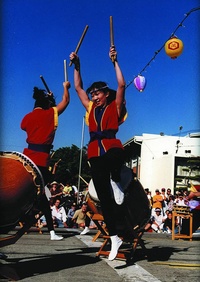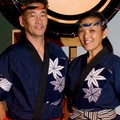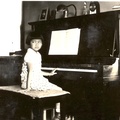The steady beat of a taiko has long provided the accompaniment for Bon-odori celebrations in Hawai`i. The taiko tradition has been passed along from generation to generation and from one family member to another. Third-generation taiko player Kay (Watanabe) Fukumoto, who learned Obon taiko from her grandfather Tomio and her father, Albert Watanabe—former Keahua plantation musician—recalls: “Ever since I can remember, my mom would take me to my dad’s taiko practices during Obon season. My sister and I would just hang out and watch the old men get together and practice and play and socialize afterwards. At a certain point while they socialized, I got up and just started pounding on the drums, and they realized that I was actually playing beats that were familiar.” At the 1970 Mantokuji Soto Mission of Pa`ia Obon, the all-male yagura musicians broke with convention by permitting Kay, a 10-year-old girl, to perform “Fukushima Ondo” with them. In 1996, after two decades of playing Bon taiko, Kay formally established a group, Maui Taiko, both to preserve this tradition and to perform the more contemporary ensemble style known as kumi daiko, a form of taiko that began in Japan and the mainland U.S. in the 1950s and 1960s.
Kumi daiko was first organized in Hawai`i when Faye Komagata founded Matsuri Taiko at the Rysenji Soto Mission of Wahiawa. This effort was born out of Komagata’s growing interest in learning and preserving the tradition of Obon taiko. When she was getting started in the 1970s, she—like Kay Fukumoto—had to challenge the conventions of the tradition in order to ensure its continuity.
Komagata recalls, “I thought if it were to be a tradition you wanted to pass down, then more people would have to learn and be involved because not necessarily the same people will be doing it forever…” As she began to learn, teach, and perform Obon taiko—sometimes over the objections of the older male drummers—she also became exposed to kumi daiko through both Japanese and mainland U.S. groups. She explains, “We’re fortunate, because along the way I did have people encouraging me and helping. Of course, there were a bunch of people thinking that I was crazy and I should do my ‘woman thing’ and stay home.”
Today there are approximately 16 kumi daiko groups in the state of Hawai`i. The groups have diversified and expanded to include not just Buddhist temple groups, but also those that combine kumi daiko with distinctive Okinawan drumming styles, youth groups, and professional performing groups. Internationally renowned taiko artist Kenny Endo and the Taiko Center of the Pacific, established in Oahu with Chizuko Endo, have played a significant role in supporting the growth of taiko on the islands and in forging new artistic directions.
This interesting mix of individual players, the geographic position of Hawai`i between Asia and the U.S. mainland, and the history and demographics of the region creates a rich context for the ongoing development of taiko. Underlying this process is an impulse—the same one that sustains the celebration of Obon—to honor past traditions through creative actions that will ensure the relevance of the past for the future.
* This article originally appeared in the Japanese American National Museum's Member Magazine Winter 2005 issue in conjunction with the exhibition Big Drum: Taiko in the United States.
© 2005 Japanese American National Museum








